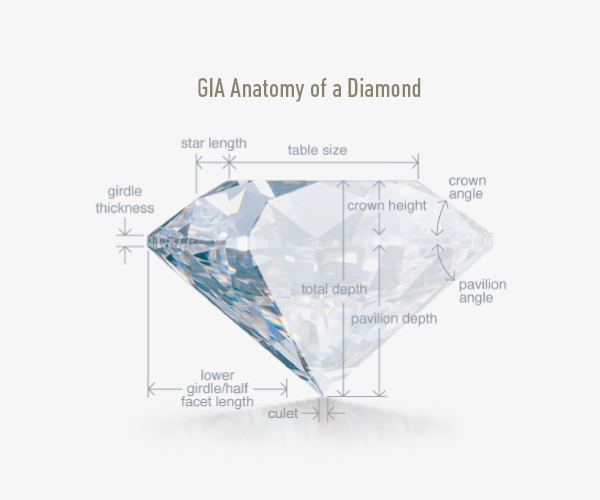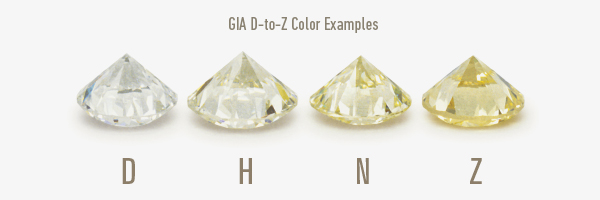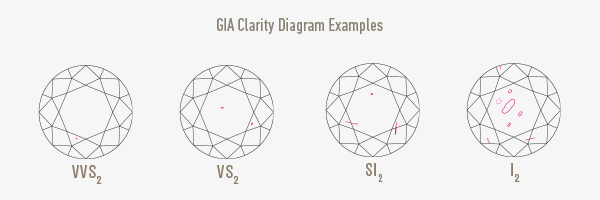Due to a fire in the neighboring building, you will find us temporarily diagonally opposite: Holzgraben 17/19.
Due to a fire in the neighboring building, you will find us temporarily diagonally opposite: Holzgraben 17/19.

No gemstone can match the brilliance and luminosity of the diamond. Its properties embody the ideals of love: the diamond is pure and nothing can destroy it, it is of indescribable beauty and very precious, it shines incredibly brightly and lasts forever.
There are four decisive criteria for assessing the quality and value of a diamond. They are called the four "Cs"; carat (the weight), color, clarity and cut.
No two diamonds are the same, even if they appear identical to the naked eye. You need to know the 4 Cs and the possibilities of their combinations to understand why two gemstones of the same size can have very different prices.
The 4 Cs explain how they are used to objectively value diamonds.

Carat is the weight measure used for the diamond. A carat can also be divided into 100 "points". A 0.50 carat therefore corresponds to a stone with 50 points or a half carat.
Two diamonds with the same carat weight can nevertheless differ greatly in price, as their quality and value also depend on their cut, color and clarity.

The closer the diamond is to colorless, the higher it is graded. The rarest and whitest are graded "very fine white" (D, E) or "fine white" (G), but most diamonds are "white" or "tinted white" and are graded H to L.
There are also extremely rare diamonds with a strong, pure color. These are called "fancies" or "fancy colors" and can come in pink, blue, yellow and many others.
The color scale ranges from D (colorless) to Z (light yellow or light brown):


The brilliance of a diamond is determined by the reflection of light. If the passage of light in the diamond is disturbed, e.g. by inclusions, some of the light is lost. The clarity of a diamond is recognized by the extent to which it is free of inclusions.
Loupe-clean stones are rare and therefore more expensive than those with inclusions. However, a large part of the internal characteristics cannot be seen with the naked eye at all, but only with a magnifying glass that magnifies ten times, and has no influence on the brilliance and beauty of a diamond.
The purity scale has 11 purity levels, ranging from Flawless (Lupenrein) to III (Pique).


The cut gives the diamond its unmistakable brilliance. The light is reflected from one facet to the other and then shines back through the top of the stone.
The cut is the criterion. The reflection of the light between the facets, which are arranged symmetrically at certain angles, causes the brilliance, while the refraction of the light in the diamond is responsible for the fanning out into the spectral colors, the so-called "fire".
The cut scale for normal round brilliants ranges from Excellent to Minor:

Round / Brilliant
Princess / Prinzess
Cushion / Cushion
Oval / Oval
Emerald
Pear / Peer
Asscher / Asscher
Heart / Herz
Radiant / Radiant
Marquise / Marquise
When purchasing a diamond, every customer receives a jewelry certificate that provides information about the material and guarantees security. From a carat size of 0.30 ct, there is the option of a diamond expertise with a GIA, HRD or IGI certificate.
A delicate beauty that has a symbolic character in many cultures and is highly coveted.
In 2012, a 7500-year-old pearl was found during archaeological excavations. This makes it the oldest pearl in the world.
To find a single "real pearl", you have to open 15,000 oysters to find one.
It was not until the beginning of the 20th century that the very complex cultivation of pearls made it possible to create a variety of different shapes and colors.
They are characterized by their very hard and robust mother-of-pearl. This natural characteristic gives saltwater pearls their unsurpassable luster.
These most valuable pearls have a white-silvery or golden hue. They are rightly called the "queen" of pearls because of their considerable size (from 8 to 20 mm) and beautiful radiance.
South Sea pearls come in a wide range of colors from silver-white to dark gold, pink, cream, champagne, yellow, light greens and blues.
A variety of different shapes such as round, oval, teardrop and baroque make the South Sea pearl a magnificent and unique jewel.
The size of this type of pearl varies between 8 and 18 mm. The color spectrum ranges from deep black to silver-grey through many shades such as violet, grey, green, magenta-blue to violet and anthracite.
As cultured pearls are a natural product created by living mussels, it is very rare to find a perfectly round pearl - the rounder the pearl, the more precious it is.
The Akoya pearl is characterized by its fine, intense, luminous lustre, which brings out the delicate shades of nature and ranges from white, creamy yellow, soft grey to rose-coloured nuances. The size of Akoya pearls varies between 3 and 10 mm.
In contrast to saltwater pearls, freshwater pearls generally do not have an inset core and are therefore almost never completely round. They reach a size of 2 to 15 mm or more. Freshwater pearls are also very popular because of their rich variety of shapes and colors. The natural colors range from white and rose, silver, bronze and lavender to apricot and violet.
Only when a pearl in a healthy oyster has had enough time to build up a thick nacreous layer around the artificially implanted nucleus can the beauty of a pearl be preserved.
Luster is the charisma of a pearl. It describes the deep, silky, fine luster of a pearl. The more complex and purer the nacre, the more beautiful the luster.
The purer the surface of a pearl, the higher its value. Absolutely perfect surfaces without growth marks (spots) are an extremely rare ideal. Visible growth marks are not considered a flaw in a pearl, but proof of the pearl's natural formation.
A distinction is made between "body color" and "overtone". The body color is the color in which the pearl can be seen. The overtone is best recognized in the reflection of the light in the pearl surface. For white South Sea pearls and Akoya pearls, "white-silver" and "white-pink" are among the best colors. For Tahitian pearls, "peacock" (black-green) is one of the most valuable colors. Gold is the most sought-after color for golden South Sea pearls.
As non-round or baroque pearls have become more and more in line with individuality in fashion, they have gained in importance. The perfect round shape is valued most highly due to its rarity. Shaping criteria are; round, drop, oval, bouton, baroque, rice grain, fluted, almost round, keshi and very rare keshi shape.
In the classic necklace range, the size varies between 3 mm and 18 mm, depending on the type. In rare cases, even larger. The value and rarity of a pearl increases with its size, provided that all other quality criteria remain the same.
A carob seed weighed approximately 0.2 grams. It was used as a weight by gold traders in Arabia. Hence the name carat. To understand what a carat means, you should first know what an alloy is.
An alloy is created when we mix and fuse pure gold (fine gold) with additional metals (e.g. silver, copper). To express how many parts of fine gold are contained in an alloy, the thousand division and the designation carat are used.
Platinum should contain at least 950 thousandths of pure platinum.
This means that 950 parts are pure platinum and 50 parts are additional metals.
Silver 925 is 925 thousandths of silver. This means that 925 parts are fine silver, 75 parts are additional metals.
Are you searching
for a specific watch,
which is not on the website?
Cut out the template and stick it onto your stamped parcel.
Alternatively, you can use the standard parcel labels from your parcel service
with the data listed below.
Cut out the template and stick it onto your stamped parcel.
Alternatively, you can use the standard parcel labels from your parcel service
with the data listed below.
Your request has been sent. We will process it as quickly as possible. Enclosed you will receive a copy of your request.
You are currently viewing a placeholder content from Vimeo. To access the actual content, click the button below. Please note that doing so will share data with third-party providers.
More InformationYou are currently viewing a placeholder content from YouTube. To access the actual content, click the button below. Please note that doing so will share data with third-party providers.
More InformationYou need to load content from reCAPTCHA to submit the form. Please note that doing so will share data with third-party providers.
More InformationYou are currently viewing a placeholder content from Instagram. To access the actual content, click the button below. Please note that doing so will share data with third-party providers.
More Information